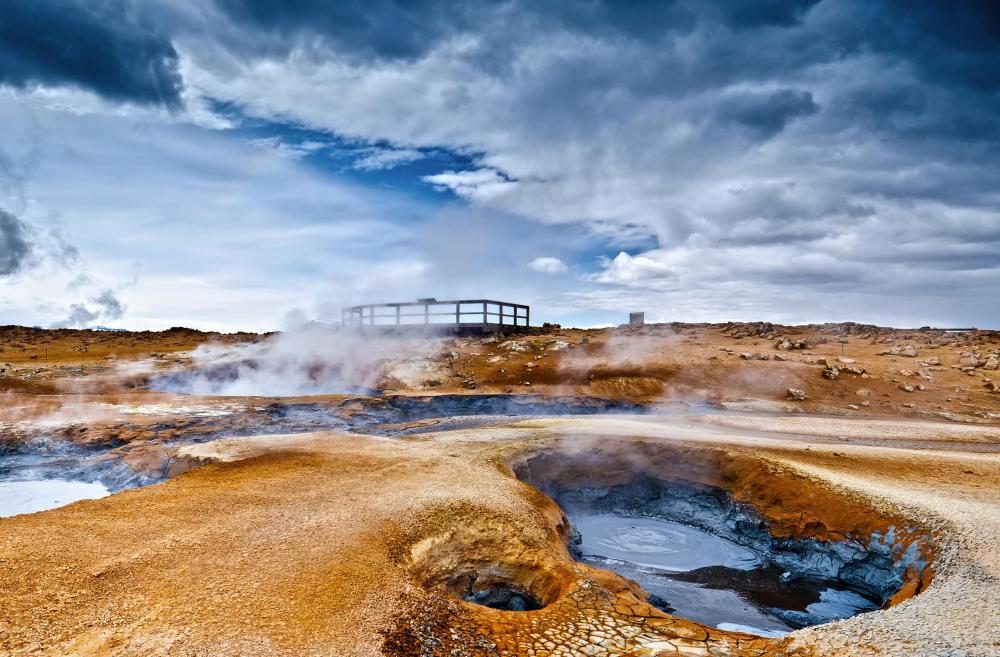At WiseGEEK, we're committed to delivering accurate, trustworthy information. Our expert-authored content is rigorously fact-checked and sourced from credible authorities. Discover how we uphold the highest standards in providing you with reliable knowledge.
What Should I Know About Iceland?
Iceland is a small island nation in the North Atlantic. It covers 39,800 square miles (103,000 sq. km), making it a bit larger than the state of Indiana. It is relatively isolated, with the nearest land masses being Greenland, the Faroe Islands, Norway, and Ireland and the United Kingdom.
The early history of the island is contentious. There is some slight evidence to suggest that the Romans or other travelers had visited by the 3rd century, and some evidence to suggest the Irish had settled there before the 9th century.

The first solid evidence of settlement comes at the end of the 9th century, however, when the Norse arrived in Iceland and settled a region they named Reykjavik, literally the Bay of Smokes, after the steam rising up from geothermal vents in the area. In the early 10th century the various chieftains of the new settlements gathered and formed a Commonwealth, with what many consider to be the first Parliament in the world.

A civil war eventually occurred among the various powerful chiefs, wearing down the country. In the mid-13th century the country joined with Norway, placing it under control of the Norwegian king. Norway and Denmark merged in the 15th century, and the island shifted to being under the control of Denmark-Norway.
In the early 19th century Norway and Denmark went their separate ways, and Denmark kept ownership of Iceland. At the beginning of the 19th century the original Parliamentary body, which had remained for centuries, was abolished. A growing nationalist sentiment through the 19th century led to its re-creation in the middle of the century, this time with a greater focus on its connection to the original Commonwealth.

In the late 19th century Denmark granted the country a great deal of autonomy, and home rule was officially achieved in 1918, with Iceland and Denmark as joined nations under one monarch. During World War II Denmark was occupied by the Germans, and the connection between the two countries was dissolved. Iceland attempted to remain neutral during the war, and in 1940 the Allied forces invaded the country, occupying it as a reserve base.
It was recognized as an independent republic in 1944, while Denmark was still occupied by Nazi Germany. Following the war, it further developed its infrastructure, and pursued a stance of neutrality. The United States took responsibility for the military defense of the island, and in return was allowed to keep a military presence there, a situation that persisted until 2006.
In the decades immediately following the war, Iceland and the United Kingdom clashed multiple times over the issue of fishing rights. The issue was finally resolved following the Third Cod War in 1975, and Iceland’s threat to pull out of NATO, when the United Kingdom agreed to not fish within 200 nautical miles (370 km) of the island.
The country's economy grew substantially during the 1980s and 1990s, with a slight recession in the 1990s hardly impeding growth. It is now the fifth most productive nation on Earth based on GDP per capita, with a robust and stable economy.
Tourism is a growing industry in Iceland as the country attempts to diversify away from a reliance on fishing, and the infrastructure has improved amazingly in the past decade. The cities themselves are some of the most amazing sites for most tourists, with the country’s 99% reliance on geo-thermal energy leading to an incredible eco-friendliness and energy abundance.
The Blue Lagoon is the area's top tourist destination. The lagoon features naturally heated seawater, loaded with all sorts of beneficial minerals, and is one of the premiere spas in the world. The area also has many hot springs. Geysir is the most famous, with its enormous jets of water after which all others in the world are named. Parks also cover the island, with Europe’s largest national park, Skaftfell, being undoubtedly the most impressive. Enormous waterfalls, the planet’s largest icecap outside of the polar north and south, and thousands of square miles of perfect habitat, make visiting this park feel like visiting a pristine planet.
Flights arrive daily in Reykjavik from most major European and American hubs. It’s also possible, although quite expensive and time consuming, to take a ferry from Denmark by way of the Faroe Islands.
AS FEATURED ON:
AS FEATURED ON:













Discuss this Article
Post your comments